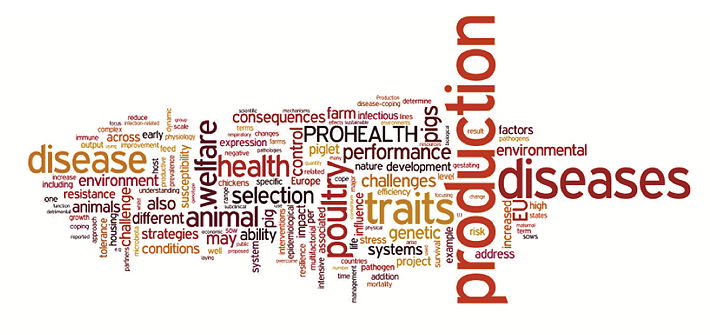Production diseases are costly to pig farms, but exactly how costly? To answer this question, the PROHEALTH project has conducted an extensive literature analysis to establish the overall estimated cost of different production diseases.
Production diseases are those that are persistent in animal production systems. Interventions to prevent them and to treat sick animals require labour and other expensive resources. Alongside the costs of such interventions, these types of diseases can also reduce productivity and so result in further income losses. This can have a substantial impact on the profitability of a farm, as well as affecting animal health and welfare.
There’s no clear or exact answer as to the total cost of production diseases. This is because the severity and the impacts of disease can vary substantially from farm to farm, and also because the current literature on this issue is limited. However, studies analysing endemic diseases in pigs suggest that in a herd facing disease problems, these are likely to cost altogether between £21 and £28 per fattened pig – a vast loss to pig producers who have persistent endemic disease present on the farm. For example, the cost of tail biting in fattening pigs was estimated on average at about £1.40 per pig produced, and parasites in pigs at almost £5 per affected pig.
Important issue
Respiratory diseases are an economically important issue in pig production. PROHEALTH’s analysis suggests that a single type of respiratory disease present in pigs can reduce economic returns of pig production by around £3.40 per finisher. Realistically, several diseases can occur in the herd simultaneously, pushing up costs to more than these estimates.
On average, Mycoplasma hyopneumoniae and Porcine Respiratory Disease Complex (PRDC) reduced the return by £2.95 per pig, and Actinobacillus pleuropneumoniae reduced returns by £4.50 per pig in an affected herd. For comparison, the impact of a well-studied non-production disease, Porcine Reproductive and Respiratory Syndrome (PRRS), has been estimated at a loss of about £4.90 per pig.
The impacts of mortality are polarised; in the individual animal the cost is very high, but when absorbed at herd level the impact can be smaller. In the studies analysed, the reduction in returns due to pre-weaning mortality was between £8.44 and £16.17 per litter, with post-weaning mortality costing between £1.40 and £2.80 per pig.
Case-by-case costs of reproductive failures and lameness can be substantial. For instance, premature replacement of a sow because of disorders in reproduction may cost between £104 and £117 per replacement. The costs of mastitis or the complex syndrome Mastitis, Metritis and Agalactia (MMA) can range up to £67 per affected sow. In the most severe cases the impacts can be even larger.
The best estimates of costs of lameness are available on a per lame pig basis. Depending on the cause of lameness, the cost in finishing pigs reported by the literature ranged from £8.40 to £47 per lame pig. In sows, the costs ranged from £102 to £127 per lame sow.
What next?
As these figures indicate, production diseases can cause substantial economic losses to pig farms if the health situation at the farm isn’t under control. However, these can be reduced by interventions such as improved nutrition, hygiene and other management practices, vaccination and genetic selection of animals.
The usefulness of interventions may vary case-by-case. Therefore, in the next few months the PROHEALTH team will examine which interventions would be the most effective in reducing production diseases, taking into account the overall cost-benefit ratios of the intervention and the impacts on animal welfare, as well as farmer and consumer acceptance of the intervention strategies.




